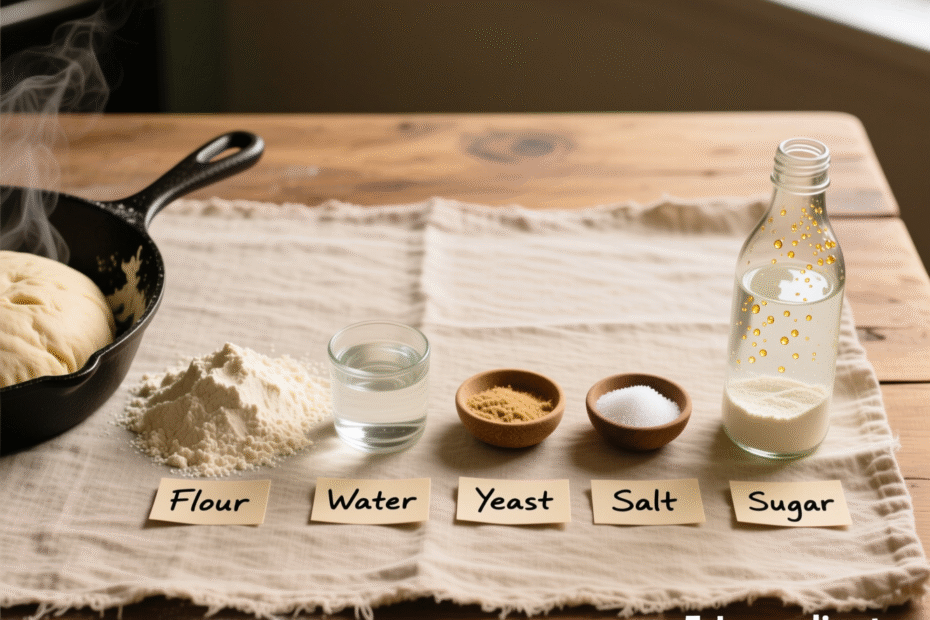Imagine pulling a warm, golden loaf of bread from your oven—its crust crackling softly, the aroma filling your kitchen—and knowing it cost you less than the price of a cup of coffee. Sounds too good to be true? It’s not. In a world where grocery bills keep climbing and food waste is a growing concern, baking your own bread with just five simple, affordable ingredients isn’t just practical—it’s empowering.
This article dives into the surprisingly simple, budget-friendly world of 5-ingredient bread baking. You don’t need fancy equipment, artisanal flours, or hours of free time. What you do need is a willingness to try something wholesome, satisfying, and shockingly economical.
We’ll explore why these minimalist recipes work so well, how they can save you money and reduce waste, and—most importantly—share five tried-and-true recipes that prove delicious bread doesn’t have to cost a fortune. Whether you’re a busy parent, a college student on a tight budget, or simply someone who loves the magic of homemade food, you’ll find value (and flavor!) in every slice.
Ready to bake bread that’s kind to your wallet and your taste buds? Let’s get started.
Why Five Ingredients Are All You Really Need
You might be surprised to learn that traditional bread—real, honest-to-goodness bread—has only four essential ingredients: flour, water, salt, and yeast. Add a fifth for flavor, texture, or convenience (like honey, oil, or milk), and you’ve got everything you need for a loaf that rivals anything from a bakery.
The beauty of minimal-ingredient baking lies in its simplicity and transparency. When you strip away preservatives, dough conditioners, and unpronounceable additives found in store-bought loaves, you’re left with food in its purest form. Not only is this healthier, but it’s also dramatically cheaper.
A 5-pound bag of all-purpose flour costs around $2.50 and can yield 4–5 loaves. Yeast is sold in bulk for pennies per use, and salt and water are pantry staples. Even if you add a splash of olive oil or a spoonful of honey, you’re still looking at a loaf that costs well under $1.
Compare that to the $4–$7 price tag of “artisan” bread at the supermarket—or worse, the $8–$12 you’d pay at a café—and the savings become obvious. Beyond cost, baking with fewer ingredients gives you control. You know exactly what’s going into your food, and you can adjust based on what you have on hand.
No eggs? No problem. Out of whole wheat flour? All-purpose works just fine. This flexibility is especially valuable during tight budget months or unexpected pantry shortages. In short, five-ingredient bread isn’t a compromise—it’s a return to basics that’s both economical and deeply satisfying.
Budget Baking: How Homemade Bread Saves You Serious Money
Let’s talk numbers—because sometimes seeing the math makes all the difference.
The average American household spends about $400–$600 per month on groceries. Bread and bakery items alone can account for $20–$40 of that, especially if you’re buying organic, gluten-free, or specialty loaves. But if you switch to baking your own 5-ingredient bread just twice a week, you could cut that cost by 70% or more.
Here’s a quick breakdown:
- Flour: $0.30 per loaf
- Yeast: $0.05
- Salt: $0.01
- Water: negligible
- Optional fifth ingredient (e.g., honey or oil): $0.10–$0.20
Total per loaf: $0.46–$0.66
Now multiply that over a month. Four loaves = under $3. Compare that to $16–$28 for store-bought equivalents. That’s $13–$25 saved monthly—money that adds up to $150–$300 a year. And that’s without even considering the reduced packaging waste or the superior freshness and taste of homemade bread.
But the savings go beyond dollars. Homemade bread rarely goes stale as quickly as commercial loaves (which often contain softening agents that accelerate staling). Plus, if a loaf does get a little dry? Turn it into croutons, breadcrumbs, or bread pudding—zero waste, maximum value.
For families, students, or anyone watching their spending, this isn’t just frugal—it’s smart kitchen economics. And the best part? It doesn’t feel like sacrifice. It feels like victory.
The Magic of Simplicity: Flavor, Texture, and Tradition in Every Loaf
There’s a reason bread has been a cornerstone of human diets for over 10,000 years: it’s nourishing, versatile, and deeply comforting. And you don’t need a dozen ingredients to capture that magic.
Think about a classic French baguette—crispy crust, airy interior, made with just flour, water, salt, and yeast. Or a rustic Italian ciabatta, born from a wet dough and a hot oven. These aren’t gourmet luxuries; they’re testaments to what happens when you let simple ingredients shine.
When you bake with only five components, each one plays a crucial role. The flour provides structure. Water activates the gluten. Salt enhances flavor and controls fermentation. Yeast brings the rise. And that fifth ingredient? It’s your creative touch—maybe a drizzle of olive oil for tenderness, a spoonful of honey for subtle sweetness, or a splash of milk for a softer crumb.
This minimalism also invites mindfulness. Without distractions, you notice the dough’s texture as it kneads, the way it swells during proofing, the sound it makes when tapped after baking. It’s not just cooking—it’s a small ritual of care and attention.
And let’s not forget the emotional payoff. There’s something profoundly grounding about creating sustenance with your own hands. In a fast-paced world of instant meals and delivery apps, baking a loaf of bread is a quiet act of resistance—and joy.
Five Foolproof 5-Ingredient Bread Recipes You’ll Love
Now for the heart of the matter: recipes that deliver on flavor, ease, and affordability. Each uses only five ingredients (including salt and water), requires no special equipment, and can be made with pantry staples.
1. Classic White Sandwich Loaf
Ingredients: All-purpose flour, warm water, active dry yeast, salt, honey (or sugar).
This soft, sliceable loaf is perfect for sandwiches, toast, or eating warm with butter. Mix, knead (by hand or stand mixer), let rise, shape, and bake. Ready in under 3 hours.
2. No-Knead Crusty Artisan Bread
Ingredients: Bread flour, water, yeast, salt, olive oil (optional but recommended).
Famous for its crispy crust and chewy interior, this recipe requires zero kneading—just mix, wait 12–18 hours, and bake in a Dutch oven. Minimal effort, maximum reward.
3. Whole Wheat Honey Oat Bread
Ingredients: Whole wheat flour, rolled oats, warm milk (or water), yeast, honey.
Nutty, slightly sweet, and packed with fiber. The oats add texture and heartiness without complicating the process.
4. Garlic & Herb Focaccia
Ingredients: All-purpose flour, water, yeast, salt, olive oil + fresh rosemary/garlic (counted as one “ingredient” for simplicity).
Press the dough into a pan, dimple with your fingers, drizzle with oil and herbs, and bake. Perfect as a side, appetizer, or base for sandwiches.
5. Banana Oat Quick Bread (Yeast-Free Option)
Ingredients: Ripe bananas, rolled oats, flour, baking soda, salt.
No yeast needed! This moist, naturally sweet loaf uses overripe bananas (saving food waste) and comes together in one bowl. Bake in under an hour.
Each recipe costs less than $1 per loaf and can be customized based on what you have. Out of honey? Use maple syrup or skip it. No fresh herbs? Dried work fine. The goal is flexibility, not perfection.
Beyond the Loaf: How Baking Bread Builds Confidence and Community
Baking bread isn’t just about feeding your body—it’s about nourishing your spirit and connecting with others.
For many, the first successful loaf is a confidence booster. “I made this?” they think, holding a warm, fragrant creation that looks and tastes like it came from a professional bakery. That sense of accomplishment spills over into other areas of life—cooking, problem-solving, even patience. Bread teaches you to slow down, observe, and trust the process.
And bread is inherently communal. Sharing a homemade loaf with a neighbor, bringing one to a potluck, or teaching a child to knead dough creates bonds. During the pandemic, sourdough starters were passed like heirlooms; today, bread-baking groups thrive online and in community centers. There’s a reason “breaking bread” is a universal symbol of friendship.
Even on a personal level, the rhythm of bread-making—mix, wait, shape, bake—can be meditative. In a world full of notifications and noise, the quiet focus required to watch dough rise offers a rare mental reset.
So when you bake a 5-ingredient loaf, you’re not just saving money. You’re joining a timeless tradition of resilience, creativity, and connection.
Conclusion: Bake More, Spend Less, Live Better
We’ve covered a lot of ground—from the economics of flour to the emotional warmth of a fresh loaf—but it all comes back to one simple truth: baking your own bread with just five ingredients is one of the most rewarding, affordable, and accessible acts of self-care you can practice in the kitchen.
You’ve learned that you don’t need expensive tools or exotic ingredients. You’ve seen how a $0.50 loaf can outshine a $6 supermarket version in taste, nutrition, and satisfaction. You’ve discovered recipes that fit your schedule, your pantry, and your values—whether that’s reducing waste, eating cleaner, or simply enjoying real food.
Now it’s your turn. Pick one recipe from this list, gather your five ingredients, and give it a try. Don’t worry about perfection. Your first loaf might be a little dense or slightly lopsided—and that’s okay. Every great baker started exactly where you are.
And when you pull that golden-brown creation from your oven, slice into it, and taste the results of your effort, you’ll understand why people have been baking bread for millennia. It’s not just food. It’s love, patience, and resilience baked into every crumb.
So go ahead—preheat your oven, dust your counter with flour, and take that first step. Your wallet (and your taste buds) will thank you.
Have you tried baking bread on a budget? What’s your favorite 5-ingredient recipe? Share your tips, triumphs, or even your “bread fails” in the comments below—we’d love to hear from you!

Thayná Alves is an influential digital content creator who has carved out a significant space in the realms of technology, finance, and entrepreneurship. Through her blog, Newbacker.com , she stands out as an authentic and accessible voice for individuals seeking practical information about investments, innovation, and emerging trends in the financial market.
